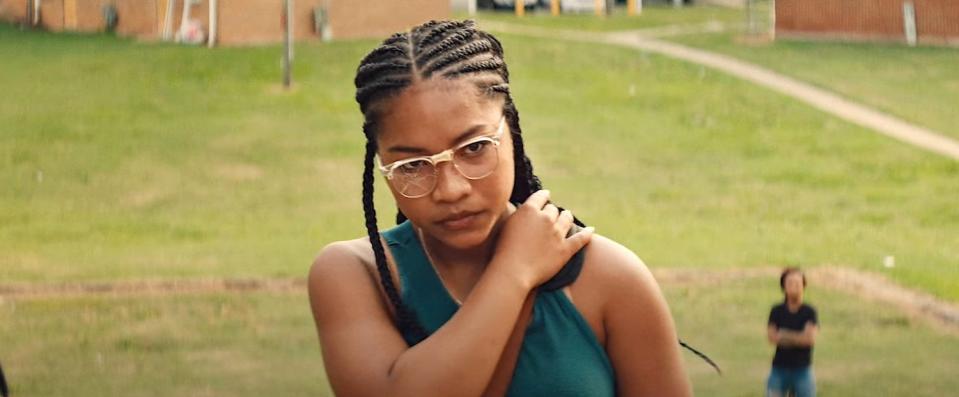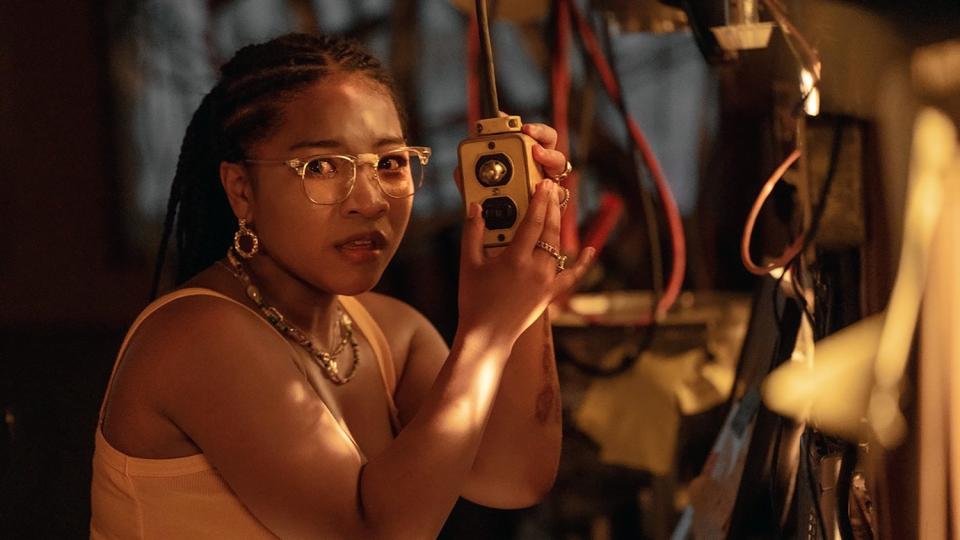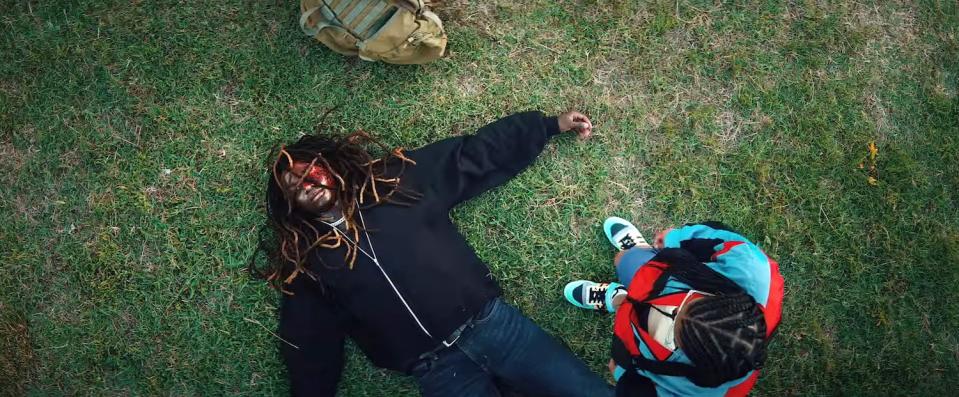New Horror Movies 2023: Angry Black Girl & Her Monster Is A Modern Frankenstein

Angry Black Girl and Her Monster, a film by Bomani J. Story, splattered ideas of existentialism, critical race theory, and mad scientists across the screen. It’s a new horror movie you just have to see.
The film, which debuted at SXSW 2023 and has since arrived in theaters, reinterprets Frankenstein for the modern age, as Blood Disgusting noted. It sinks its teeth into narration, using abstract motifs about life and death to allude to far larger pictures in our society. Since what could be larger as a concept than life or death? Maybe the fact that communities of color may not ever have the ability to live life long enough to see old age or a peaceful death because of the brooding racism peddled in our system. Ironically, the film mirrors the quote, “Be the change you want to see in the world,” as the main protagonist Vicaria (played by Laya DeLeon Hayes) sets out on a mission of activism in her own way. Those ways are to find a cure for death.
More from StyleCaster
What Does 'Flow' Mean? Here's How Katie Couric & Judy Greer Achieve Being 'In The Zone'
Abortion Pill Activists Feel Like They're 'Running a Drug Cartel in Order to Help People'
Vicaria’s obsession with the living and dying stems from the trauma of loss. Her brother Chris died at the hands of police brutality, and because Chris was taken away from her, it catapults this unacceptance of death. Vicaria begins to collect and curate organs to put the botched body of her brother back to life. The film really begins the moment breath is brought back into the mangled version of Chris, as it trickles a domino effect for the following characters, Kango (played by Denzel Whitaker, the lead drug dealer of the neighborhood), Jada (played by Armani Summer, Vicaria’s younger sister who develops a close-knit bond with this version of Chris), and Aisha (played by Reilly Brooke-Smith, Vicaria’s older sister whose opinions on nationalism and blackness clash with her own).

As much as Chris is flesh, his unspoken presence throughout the film represents an infinite list of meanings. Since Chris isn’t actually who he used to be when he comes back to life, it mirrors the absence and loss Black families suffer when their children have been lost to abuse and in this case—police brutality.
Click here to read the full article.
Chris emulates the pain and suffering Black people go through when they’ve been scrutinized, ostracized, and discriminated against just because of their outer flesh. In those cases, they may still be breathing, but the soul of their person—the love and positivity they may have for the world dwindles, and almost dies inside because of how negatively they are seen. In ways, Vicaria’s destiny to fix Chris is a cry to fix herself. If Vicaria sees the world in blood because of her significant loss, saving Chris would mean saving her outlook on the world she’s a part of.
In The Angry Black Girl and Her Monster, Story puts the film together with excellence, using motifs of red to signify this surrounding of death and blood as an allegory to gang violence and police brutality. He uses a plethora of Black hairstyles for Vicaria, Aisha, and Jada to signature the many shades of Blackness and uses the feuds between two of the three sisters to showcase that even in their different perceptions of how to save the world, they still arrive in the same boat. That boat consisted of grief, survival, and thankfully, hope.
The film’s ultimate goal is to produce the question: who is the real monster of our society? Is it Chris because of who he’s become? Does it have to be? Chris is only a monster because he’s become unwhole. Is it Vicaria for creating Chris this way? Is she a monstrosity for her obsession with death, or doesn’t every Black person have a relationship with life a little bit more personal? A little bit more dissatisfactory, heinous, and even stolen. Kango’s character is critiqued because of how his selling of drugs has also ripped open their community. Wouldn’t Kango be just as much of a product of society as his business and capitalistic desires are? All of these characters and their behavior derive from one origin point, and if one focuses hard, the pointer finger of blame moves farther from the people and more to the system overhead.
In a conversation with Bomani J. Story and Laya DeLeon Hayes, we tear apart the film’s meaning to build an even better one.

I’ll start with you, Bomani. What inspired you to take the story of Frankenstein and relate it to blackness and even teenage rage or femininity?
BOMANI J. STORY: It starts with the novel itself, right? And I read that book, and I was very horrified by it. And I realized that these themes are very resonant today. Growing up, I had two older sisters who mentored and shepherded me throughout my life. And when one of them would rant—I was around 11—one of them would just rant to me about their frustrations. We could just be walking to the liquor store or something like that, and they would just be, you know, ranting about stuff. It was important to me to capture them, so I can be a part of that. I was very distraught, especially being a younger brother since I couldn’t protect them since I was much smaller and younger. So, to me, the inspiration starts there. I also wanted to make sure I put some respect for Mary Shelley’s name.
Throughout the film, there’s this tension with red. What does red signify to you? And what were your intentions when using the color?
STORY: I think red’s a very powerful color with a lot of different meanings. It can be blood, it can be death, it can be love, it can be passion—you know what I mean? To me, red has all those things attached to it. It’s such an interesting color to me. Colors in general are pretty interesting to me, but I think red is a very fascinating color because, I feel like those two extremes of red can mean death, it can mean stop. And it can also mean love, like, all in the same situation. That is really what’s fascinating to me.
To me, it’s the dehumanization of Blackness. In all its facets. I hope that this can help shine a light on that and help open up the conversation of how we’re treated in certain ways and, whether it’s micro-aggression or macro, it’s affecting us in different ways.
—BOMANI J. STORY
When the film starts you have the bandanas. And then we meet Vicara, and her room is majorly red. Not to mention all of the gory events that happen, I was like, “Something’s simmering.” I’ll go to you Laya, in three words, how would you describe your character?
LAYA DELEON HAYES: Oh, gosh, three words. Just three? I would say intelligent, passionate, and I think compassionate. With the movie, you can also say mad scientist.
How did you prepare for the role? Did you watch, read or listen to anything specific to embody her character?
HAYES: To get into that headspace was, of course, a bit difficult. You know what happened before we started filming? Kendrick Lamar released his new album Mr. Morales & the Big Steppers, and it played for the entirety of shooting—I just listened to that album constantly. With every character, I created playlists and obviously did like backstories. And then I had never read Frankenstein before filming this movie, I knew the story of Frankenstein, but, to actually sit down and read the book, and actually get my hands on the pages was extremely helpful in preparing. Plus, Bomani is so great because he’s so specific with the vision that he has for the film. But he gives you a lot of room to play. And he doesn’t give you all the answers, which was one of the things in the beginning, I was like, “What does this mean?” And he was always just giving me a lot of freedom to figure it out and see what felt right. As an actor, I can always appreciate that, and in the end, it made the entire experience much more fulfilling and completely freeing. So that also went into preparation.
There’s that scene where Vicaria is creating Chris, and she’s laughing and laughing—are you into gory movies at all or is that like something completely opposite to your personality?
HAYES: I was horrified, I’m a scaredy cat. I was scared, I had to pinch myself the entirety of filming that scene. I was like, “It’s not real, it’s not real, it’s not real!” I always wanted to do a horror movie, honestly. As an actor, that was something on my bucket list. I was like, “It would be so fun!” And everything was good. I felt like I was scaring myself and I was like, “Okay, my limits were fine.” I wasn’t pushing past them, until the day I had to start sewing on an eyeball and seeing the actual blood and guts and everything. It helped me get into character, of course, but it was definitely hard to separate. Like, okay, for her, this is normal, this feels completely correct. I just remind myself like, “No, this is just what it is.” But every time we yelled cut, I think I just went, “Oh my gosh.”
Which scenes were the most intense to film or direct? For both of you?
STORY: For me, there are probably three scenes that come to mind that are the toughest. One was when she’s crying. That one was pretty tough to do. And the one where she’s arguing with Kango in the bedroom, that one was pretty rough. But honestly, the one that scared me the most was that dinner table scene. It was very, very scary, because one—it covers so much ground emotionally. And I got a little bit scared about how far Aisha and Vicaria were going to take this argument. I was like, “Maybe we should dial back before we go in there,” and then I was talking to Reilly, who plays Aisha, and she was like, “No, you know, we got to do this, this is—this is family. We’ll take it all the way, we won’t hold back.”
I feel like the film touches on so many different concepts. If there’s one thing audiences should take from this film, what should it be?
STORY: To me, it’s the dehumanization of Blackness. In all its facets. I hope that this can help shine a light on that and help open up the conversation of how we’re treated in certain ways and, whether it’s micro-aggression or macro, it’s affecting us in different ways. So, I hope when someone watches this movie, they think twice about certain things, something as simple as a name, you can do so much damage and so that’s what I hope. I think that seeing that dinner table scene was so important to me. I think a showcase of us just being able to exist, you know? And then what happens when people start fucking with us? Like, if you just left us alone then…

HAYES: I fully agree with everything that Bomani said. I hope that they just leave with more ideas and thoughts. I hope it’s a thought-provoking film for anyone who watches it. And again, you look at these characters, and you look at the situation, especially the one Vicairi is put in, and you actually think about who the real monster is, and what those monsters are. That, if the monster even lives within you, you know, I hope people can look at that. And again, try to find some type of change within our film.
STORY: Yeah, to me a movie in a way—it’s an emotional experience. And I hope that people are able to have an experience and an emotional ride with this movie. It’s what I always wanted to achieve—a lot of great stories that I love are able to hit, you know? Oh, I’m scared, I’m going on this emotional ride, but I walk away from the movie with something that makes me think, at the same time, so I hope this movie is able to capture all those elements at the same time.
That’s funny Laya, that you talked about who the real monster is, as that legitimately was my last question. To answer, out of all the characters, who do you think the real monster is? Is it Vicaria or Kango? Is it no one? Is it racism?
STORY: [To Hayes] Don’t answer that question, don’t answer. No disrespect but to me, that’s the beauty of storytelling. You let people have their interpretation. Because after a certain point, this movie is going to be engaging with an audience and I’m hoping that it can connect. So what people want to say about it, how they talk about it, what they do with it, I think that’s important. As then it becomes theirs, which is what we want, you know? So that doesn’t answer your question, but I hope it is satisfying for you.
The Angry Black Girl And Her Monster is in cinemas now.
Best of StyleCaster

